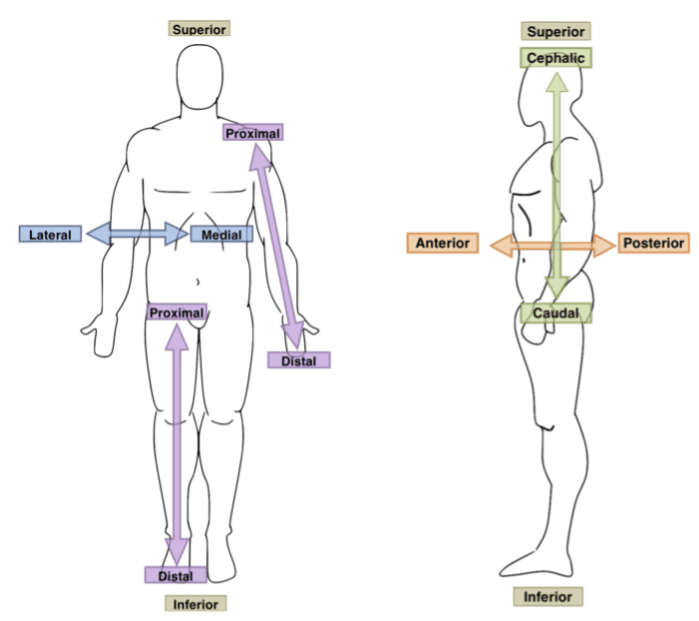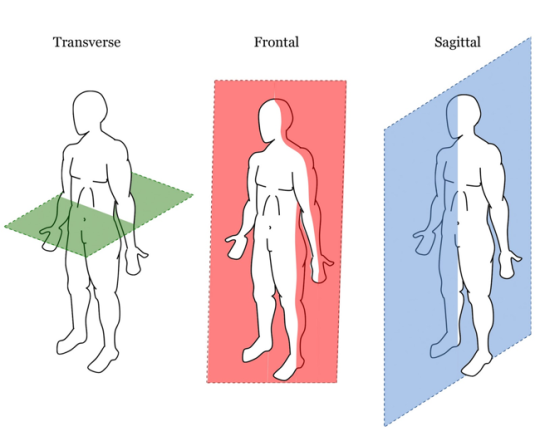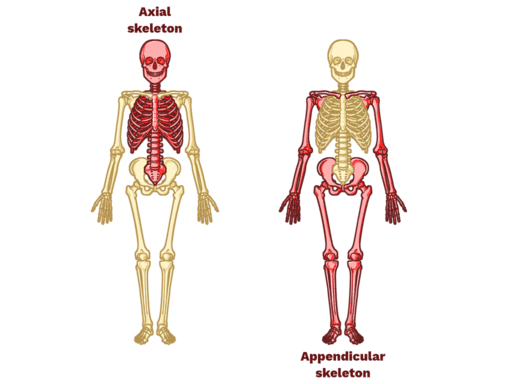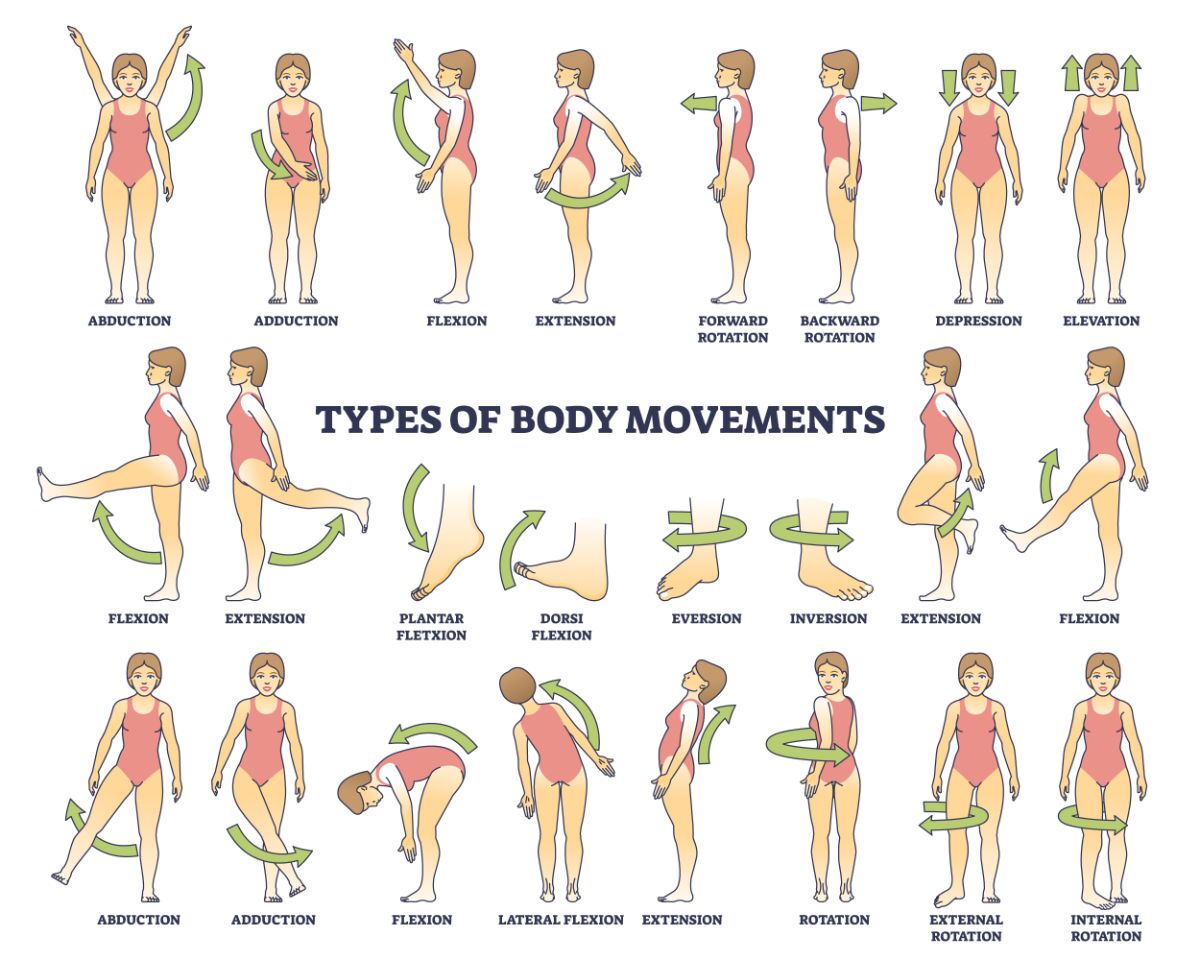Anatomical Position, Directional Terms & Planes
Main Questions to Answer:
- What is the anatomical position?
- What are the directional terms used in anatomy?
- What are the anatomical planes and sections?
The Problem: Why Do We Need a Standard?
When we describe where something is on the body, it can be confusing. If a person is holding their hand with the palm facing up, a circle on it is on the "front." If they turn their hand so the palm faces down, is that circle now on the "inside" or still the "front"? This confusion is why anatomists and medical professionals created a single standard position to use as a reference point, no matter how the body is actually positioned.
The Golden Rule
No matter how a patient or a body in an image is actually positioned (sitting, lying down, etc.), you always describe it as if it were in the anatomical position.
The Solution: The Anatomical Position
The Anatomical Position is the universal starting point for describing any part of the body. It is an initial point of reference to accurately describe location and direction.
The Rules of Anatomical Position:
- The person is standing up straight (erect).
- They are facing forward.
- Their arms are down at their sides.
- Their palms are facing forward.
- Their thumbs are pointing away from the body (to the side).
Most Important Rule
All descriptions are from the patient's point of view, not yours. The patient's left is always their left, even if it's on your right.

Anatomical Terms of Position (Directional Terms)
These terms are like a GPS for the body. They are used in pairs of opposites and help describe where one body part is in relation to another. To accurately describe body parts and their positions, we use a set of directional terms.

Paired Terms:
Anterior (Ventral)
Towards the front of the body.
Example: "The sternum (breastbone) is anterior to the vertebral column (spine)."
Posterior (Dorsal)
Towards the back of the body.
Example: "The vertebral column (spine) is posterior to the sternum."
Superior
(Used for Axial Skeleton - Trunk/Head)
Towards the top or head.
Example: "The nose is superior to the mouth."
Inferior
(Used for Axial Skeleton - Trunk/Head)
Towards the bottom or feet.
Example: "The mouth is inferior to the nose."
Cranial (or Cephalic)
Towards the head.
Example: "The skull is cranial to the neck."
Caudal
Towards the tail or bottom.
Example: "The neck is caudal to the skull."
Medial
Towards the midline of the body.
Example: "The nose is medial to the ears."
Lateral
Away from the midline of the body.
Example: "The ears are lateral to the nose."
Superficial (External)
Situated on the surface of the body.
Example: "The skin is superficial to the bones."
Deep (Internal)
Situated towards the inside of the body.
Example: "The bones are deep to the skin."
Proximal
(Used for Appendicular Skeleton - Limbs)
Closer to the origin or attachment point of a limb.
Example: "The elbow is proximal to the wrist."
Distal
(Used for Appendicular Skeleton - Limbs)
Farther from the origin or attachment point of a limb.
Example: "The wrist is distal to the elbow."
Planes and Sections
To study the internal anatomy, the body is often sectioned (cut) along an imaginary flat surface called a plane. The cut itself is called a section.

The Three Main Body Planes:
1. Sagittal Plane
A vertical line dividing the body into left and right parts.
2. Coronal (Frontal) Plane
A vertical line dividing the body into anterior and posterior parts.
3. Axial (Transverse) Plane
A horizontal line dividing the body into superior and inferior parts.
Special Note: Viewing Axial Sections
The standard in medicine (for CT/MRI scans) is the Radiology View: you are looking up from the patient's feet toward their head. This is why the Right/Left markers on a scan seem reversed.

Regional Terminology
This is like learning the names of countries on a map, but for the human body. We divide the body into two main areas: Axial (head, neck, trunk) and Appendicular (limbs).
A) Axial Skeleton Regions (Head, Neck, and Trunk)
Frontal: Forehead
Orbital: Eye area
Nasal: Nose area
Oral: Mouth area
Mental: Chin
Occipital: Back of head
Otic: Ear area
Cervical: Neck
Sternal: Breastbone area
Axillary: Armpit
Mammary: Breast area
Scapular: Shoulder blade
Vertebral: Spine area
Abdominal: Belly
Umbilical: Belly button
Inguinal: Groin
Pubic: Genital region
Lumbar: Lower back
Sacral: Near tailbone

B) Appendicular Skeleton Regions (The Limbs)
1. Upper Limb (The Arm)
Acromial: Tip of shoulder
Brachial: Upper arm
Antecubital: Front of elbow
Olecranal: Back of elbow
Antebrachial: Forearm
Carpal: Wrist
Palmar: Palm of hand
Pollex: Thumb
Digital: Fingers
2. Lower Limb (The Leg)
Coxal: Hip area
Femoral: Thigh
Patellar: Kneecap
Popliteal: Back of knee
Crural: Shin area
Sural: Calf area
Fibular: Side of lower leg
Tarsal: Ankle
Calcaneal: Heel
Hallux: Big toe
Digital: Toes
Body Movements
Describing how our bodies move seems simple, but terms like "up," "down," or "sideways" can be confusing because their meaning changes depending on our position. To create a clear and universal language for healthcare professionals, trainers, and scientists, anatomy uses a specific set of terms for every possible motion.
All of these movements are described from a single, consistent starting point: the Anatomical Position. These notes break down the essential anatomical movement terms, providing simple definitions and memory aids to help you understand and describe motion accurately.

Core Movement Pairs
Flexion
Bending a joint or decreasing the angle between two body parts.
Example: Bending your elbow.
Extension
Straightening a joint or increasing the angle between two body parts.
Example: Straightening your knee.
Abduction
Moving a limb away from the body's midline.
Example: Lifting your arm out to the side.
Adduction
Moving a limb toward the body's midline.
Example: Bringing your arm back to your side.
Rotational Movements
Medial (Internal) Rotation
Rotating a limb inward, toward the body's midline.
Example: Turning your foot inward to be "pigeon-toed."
Lateral (External) Rotation
Rotating a limb outward, away from the body's midline.
Example: Turning your foot outward.
Specialized Movements
1. Forearm: Supination & Pronation
Supination: Rotating the forearm so the palm faces up.
Pronation: Rotating the forearm so the palm faces down.
2. Ankle: Dorsiflexion, Plantarflexion, Inversion & Eversion
Dorsiflexion: Pointing your toes up toward your shin.
Plantarflexion: Pointing your toes down, away from the shin.
Inversion: Turning the sole of the foot inward (medially).
Eversion: Turning the sole of the foot outward (laterally).
3. Scapula (Shoulder Blade)
Elevation: Moving the shoulder blades up (shrugging).
Depression: Moving the shoulder blades down.
Protraction: Moving the shoulder blades forward and apart.
Retraction: Pulling the shoulder blades back and together.
Complex Movement
Circumduction
A circular, cone-like movement of a limb that combines flexion, extension, abduction, and adduction.
Example: Making large circles with your arm or leg.

Body Positions
These are standardized postures or orientations of the human body used in anatomy, nursing, surgery, and critical care to ensure consistency in patient care, examination, and procedural execution.
1. Supine Position
The patient lies flat on their back, facing upward, with arms typically at their sides and legs extended.
Clinical Uses & Advantages
- Physical Examination (anterior)
- CPR & Surgeries
- Comfort & Accessibility
- Stable Hemodynamics
Disadvantages & Risks
- Risk of Aspiration
- Respiratory Distress
- Pressure Injuries (sacrum, heels)
- Urinary Stasis
2. Prone Position
The patient lies flat on their stomach, facing downward, with the head turned to one side.
Clinical Uses & Advantages
- Posterior Body Procedures (e.g., spine surgery)
- Improving Oxygenation in ARDS
- Secretion Drainage
- Pressure Relief (anterior)
Disadvantages & Risks
- Difficult Airway Management
- Access Challenges (IVs, drains)
- Pressure Injuries (face, eyes, chest)
- Cardiovascular Compromise
3. Lateral (Side-Lying) Position
The patient lies on either their left or right side, typically with a pillow between the knees.
Clinical Uses & Advantages
- Aspiration Risk Reduction
- Rectal Procedures & Enemas
- Hip or Kidney Surgery
- Pressure Ulcer Prevention
Disadvantages & Risks
- Nerve Compression (brachial plexus)
- Pressure on Dependent Shoulder/Hip
- Requires Careful Spinal Alignment
- Limited Access to Opposite Side
4. Fowler’s Position
Patient lies on their back with the head and trunk elevated (Semi-Fowler's: 30-45°, High Fowler's: 60-90°).
Clinical Uses & Advantages
- Facilitates Breathing (respiratory distress)
- Reduces Aspiration Risk During Feeding
- Increases Comfort
- Reduces Intracranial Pressure (ICP)
Disadvantages & Risks
- Shearing Forces (sliding down bed)
- Pressure Ulcers (sacrum, heels)
- Risk of Foot Drop
- Can Cause Hypotension
5. Trendelenburg Position
The patient lies supine with the entire bed tilted so the head is lower than the feet.
Clinical Uses & Advantages
- Pelvic/Lower Abdominal Surgeries
- Central Venous Catheter Insertion
- Management of Air Embolism
- Temporarily Improves Venous Return
Disadvantages & Risks
- Increases Intracranial Pressure (ICP)
- Worsens Respiratory Distress
- Cardiovascular Strain
- High Risk of Gastric Reflux/Aspiration
6. Reverse Trendelenburg Position
Patient lies supine with the entire bed tilted so the head is elevated above the feet.
Clinical Uses & Advantages
- Reduces GERD Symptoms
- Decreases Intracranial Pressure
- Improves Visualization in Upper Abdominal Surgery
- Reduces Head/Neck Swelling Post-Op
Disadvantages & Risks
- Can Cause Hypotension
- Increased Pressure on Feet
- Risk of Patient Sliding Down
7. Lithotomy Position
Patient lies on their back with hips and knees flexed, and feet often placed in stirrups.
Clinical Uses & Advantages
- Childbirth & Gynecological Procedures
- Urological & Rectal Surgeries
- Excellent Perineal Access
Disadvantages & Risks
- High Risk of Nerve Injury (peroneal)
- Musculoskeletal Strain on Hips/Knees
- Risk of Compartment Syndrome
- Cardiovascular Effects
8. Sims' (Semi-Prone) Position
Patient lies on their left side with the right leg sharply flexed towards the chest; the left arm is behind the body.
Clinical Uses & Advantages
- Rectal Examinations & Enemas
- Prevents Aspiration in Unconscious Patients
- Comfortable Resting Position
- Reduces Pressure on Sacrum
Disadvantages & Risks
- Limited Access to Body
- Pressure on Dependent Shoulder/Hip
- Difficult to Maintain Position
9. Dorsal Recumbent Position
Patient lies supine with knees bent and feet flat on the bed.
Clinical Uses & Advantages
- Female Catheterization
- Perineal Care & Vaginal Exams
- Reduces Pressure on Heels
Disadvantages & Risks
- Pressure on Sacrum
- Can Cause Back Strain
- Respiratory Compromise
10. Genu-Pectoral (Knee-Chest) Position
Patient kneels on the bed with their chest resting on a pillow, thighs perpendicular to the bed.
Clinical Uses & Advantages
- Umbilical Cord Prolapse (Emergency)
- Rectal/Sigmoidoscopy Procedures
- Maximal Rectal Exposure
Disadvantages & Risks
- Extremely Uncomfortable
- Compromises Respiration
- Cardiovascular Strain
- High Risk of Pressure Injuries
Test Your Knowledge
Check your understanding of the concepts covered in this post.
1. What is the main reason anatomists and medical professionals use the Anatomical Position as a standard reference?
- To ensure all patients are examined in the same physical stance.
- To simplify the naming of body organs.
- To create a consistent and unambiguous reference point for describing body parts, regardless of actual body orientation.
- To perform surgery more efficiently.
2. The sternum (breastbone) is _________ to the vertebral column (spine).
- Posterior
- Lateral
- Anterior
- Superior
3. Which body plane divides the body into anterior (front) and posterior (back) parts?
- Sagittal plane
- Axial plane
- Coronal plane
- Transverse plane
4. Moving a limb away from the body's midline is described as:
- Adduction
- Flexion
- Abduction
- Extension
5. The anatomical term for the back of the knee is:
- Patellar
- Crural
- Popliteal
- Femoral
6. When describing the left and right sides of the body in an anatomical context, whose perspective should always be used?
- The observer's (your) perspective.
- The patient's perspective.
- The perspective of the person taking the image.
- It depends on the specific body part being described.
7. Rotating the forearm so the palm faces up, as if holding a bowl of soup, is called:
- Pronation
- Eversion
- Supination
- Dorsiflexion
8. In a standard radiology view (for CT scans & MRIs) of an axial section, if you are looking at the image, your right hand will correspond to which side of the patient?
- The patient's right side.
- The patient's left side.
- The patient's superior side.
- The patient's inferior side.
9. The wrist is _________ to the elbow.
- Proximal
- Superior
- Medial
- Distal
10. Circumduction is a complex movement that involves a combination of which of the following?
- Only flexion and extension.
- Only abduction and adduction.
- Flexion, extension, abduction, and adduction.
- Rotation and pronation.
11. A vertical line that divides a structure into left and right parts is called a ____________ plane.
12. The movement that involves moving a limb toward the body's midline is called ____________.
13. The anatomical term for the forearm (from the elbow to the wrist) is ____________.
14. Moving the shoulder blades up, such as in shrugging, is known as ____________.
15. When describing body parts, the term ____________ means situated towards the inside of the body.
Quiz Complete!
Your Score:
0%
0 / 0 correct